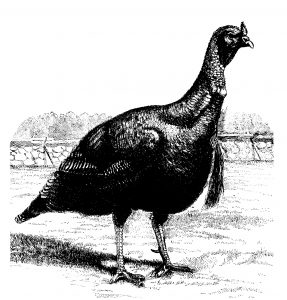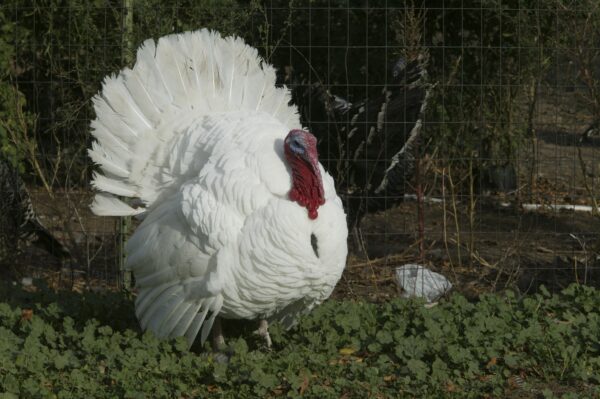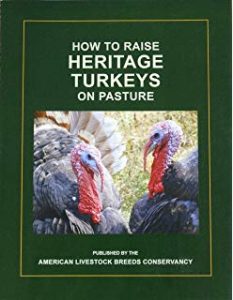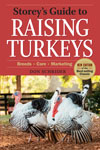
Breed Facts
Status:
Threatened
Use:
Meat
Egg Color:
Pale cream to medium brown with spotting
Egg Size:
Large
Weight:
Male Young – 25 lbs. Mature – 33 lbs.
Female Young – 16 lbs. Mature – 18 lbs.
Temperament:
Highly dependent on socialization and selection by breeder; some select for aggressive, others docile
Characteristics:
Good foragers. Be sure to get stock from a reputable breeder so you don’t get a Broad-breasted White/White Holland cross
WHITE HOLLAND TURKEY
The White Holland was the most important white-feathered turkey variety throughout most of American history. The mutation to the white color – which is actually a lack of color – is an ancient one. The Aztecs and others selectively bred white turkeys, which were certainly among the stocks sent to Europe. In Austria and in Holland, white turkeys were favored. It is quite possible, though not documented, that Dutch settlers or other European immigrants came to the Americas with White turkeys. By the 1800s, a white variety – now called the White Holland – was known in the US. It was recognized in the American Poultry Association Standard of Perfection in 1874.
The name White Holland implied Dutch origins, but it is an American variety developed from white sports of the Bronze turkey variety. The White Holland became a popular variety, especially in New England, holding its own well into the 20th century. Though less numerous than the Bronze and smaller in size, the White Holland matured earlier and offered a cleaner carcass than dark-colored birds.
The White Holland was the only commercial white variety in the first half of the 1900s. The White Holland’s advantage has been its lack of dark pinfeathers. This trait often led to market advantage even though the birds were not as large as the Bronze.
Despite this illustrious past, today the White Holland is one of the rarest and most difficult to authenticate of the turkey varieties. Producers came to want the best of both worlds – a large, white-feathered variety. In the early 1950s, researchers at Cornell University and elsewhere in the US began crossing the White Holland and Broad-breasted Bronze. By the 1960s, the Broad Breasted White (or Large White) had surpassed the Bronze for commercial production. This variety dominates the turkey industry today.
The White Holland is a distinctive and historic population that is close to extinction. They are seen occasionally at poultry shows, but these birds often have wide breasts and short legs, reflecting genetic influence from the Large White. White Hollands have longer legs and smaller breasts than Broad-breasted Whites, and retain the ability to mate naturally. The American Poultry Association both recognized this fact and confused the issue in 1983 when a change in the White Holland standard added the following: “May be referred to in commercial terminology as Broad-breasted Whites or Large Whites.” Thus, the two varieties have merged, with the White Holland absorbed into the Large White. The same change has taken place in Britain, with the lumping of all white varieties into a population called the “British White” turkey.
The White Holland turkey is showy in appearance, with snow-white feathers and a red to bluish head. The beard is black, the beak is pink to horn colored and the throat and wattles are pinkish-white. Shanks and toes are pinkish-white, and eyes must be brown. (Some believe that the original eye color was blue, but the APA standard specifically states that eyes are brown.) The standard weight for a young tom is 25 lbs. and 16 lbs. for a young hen. A mature tom can weigh 33 lbs.; a mature hen is smaller, at 18 lbs.
Hens lay eggs that are large and pale cream to medium-brown with speckles. They are good mothers but may break eggs because of their size. They produce a nice carcass but that of the heritage White Holland is smaller than that of the Broad-breasted White.
They can have nice personalities, but it is advisable to research lines and buy from a breeder who knows the temperament of his stock. They like to forage so they do well in free-range environments. True White Holland turkeys are a good beginner breed, but they are difficult find. However, with some careful selective breeding by fanciers who are interested in preserving this unique genetic resource, White Holland Turkeys can be saved from being lost through cross breeding with broad-breasted birds.
Did you know:
Did you know Milking Devon cattle have been in America for more than 400 years? They arrived with the Pilgrims in 1623, swimming ashore at Plymouth, Massachusetts. Learn more about this critically endangered breed at Milking Devon Cattle – The Livestock Conservancy

Breed Facts
Status:
Threatened
Use:
Meat
Egg Color:
Pale cream to medium brown with spotting
Egg Size:
Large
Market Weight:
16 – 25 lbs
Temperament:
Highly dependent on selection by breeder, some select for aggressive, others docile
You may be interested in…




